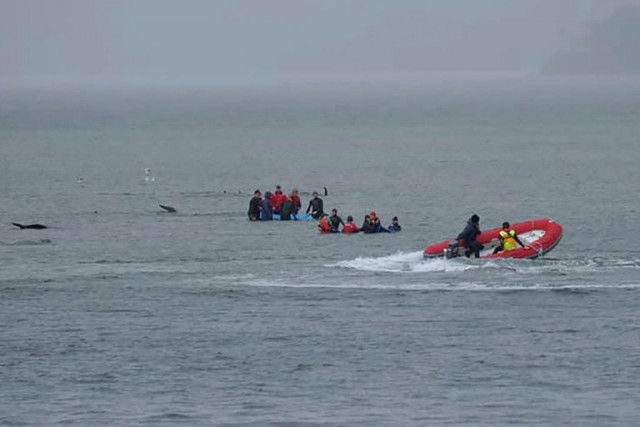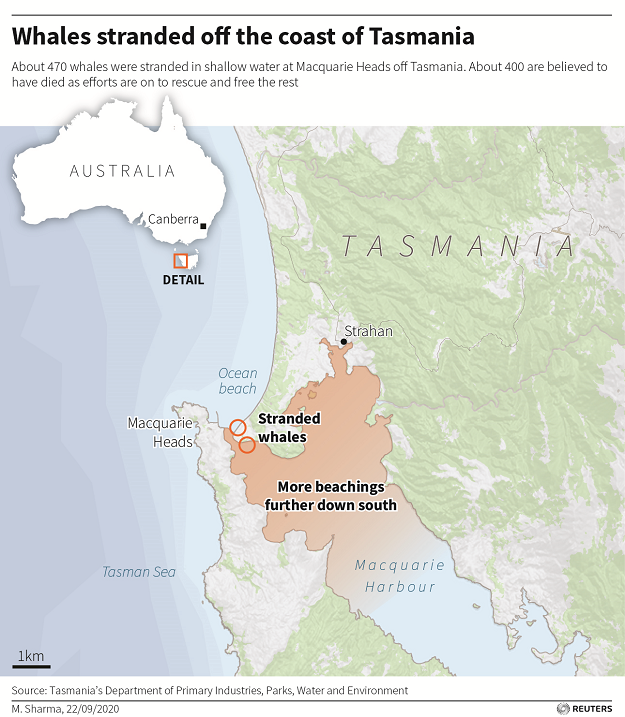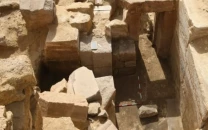Australia plans disposal of hundreds of stranded whale carcasses
As rescue attempts for remaining survivors of one of the world’s worst mass stranding expected to extend another day

Australian officials were focusing on the grim task of disposing of almost 400 whale carcasses on Thursday, while attempts to rescue the few remaining survivors of one of the world’s worst mass strandings was expected to extend another day.
Rescuers had managed to free almost 90 of the long-finned pilot whales beached off the country’s remote southern coast by late Thursday.
The majority of those freed had reached deeper water, officials said, but four had to be euthanised and others might return when the tide turns.
The clock was ticking for a small group of whales still floundering in shallow water on a wide sandbank, four days after the 470-strong pod was first spotted off the northwest coast of the island state of Tasmania.
“There is a likelihood that we will be continuing the rescue efforts tomorrow,” said Nic Deka, the incident controller for the state government’s Parks and Wildlife Service.
“While we have live animals that have a chance and we have the crew to shift them, we will give it a go,” he told a media briefing.
After a positive veterinary assessment, a rescue attempt would continue on Friday for a mother and calf that appeared in footage posted by local media on Twitter. The video showed the calf swimming among rescuers as they tried to save its mother.
Alongside these measures, authorities were also developing a plan to dispose of around dead 380 whales at sea.
Options included loading the carcasses onto a barge or gathering them into a group to tow, Deka said, adding that a barge with a crane attached was due to arrive on Monday.
“Realistically it could take several days. We are intending to start tomorrow. If we get a method that works efficiently it may be by early next week we will have made a real dent.”

‘ETHICAL AND HUMANE’
Euthanising those animals too exhausted to swim to safety was another daunting but necessary task, experts said.
“For large whales, very sadly, it could take weeks for them to die, and they get blistered in the sun, so you would be thinking about an ethical and humane thing to do,” Mike Double, a zoologist that leads the Australian Marine Mammal Centre, told Reuters.
While larger whales can require a lethal dose of potassium chloride to the heart or explosives, smaller whales like the long-finned pilots are usually shot with a firearm.
More whales were likely to be euthanised on Friday, Deka said.
The effort has taken a physical and emotional toll on rescuers, and a fresh crew was due to arrive in the next day, Deka said, adding that counselling was being made available to those involved.
“The emotional toll can be significant,” the department’s wildlife biologist Kris Carlyon said.
“Most crew are really focused on just getting the job done, so it might be a little bit later that they start to really think about it, and it starts to sink in.”
More than 60 government scientists and volunteers had dashed to the remote location, braving freezing cold waters in an arduous refloating process.
As many as four or five people per whale were needed to attach slings to the animals and guide them as they were pulled to deeper water by boats.
The stranding, the biggest on record in modern Australia and one of the largest in the world, has drawn attention to a natural phenomenon that remains largely a mystery to scientists.



















COMMENTS
Comments are moderated and generally will be posted if they are on-topic and not abusive.
For more information, please see our Comments FAQ